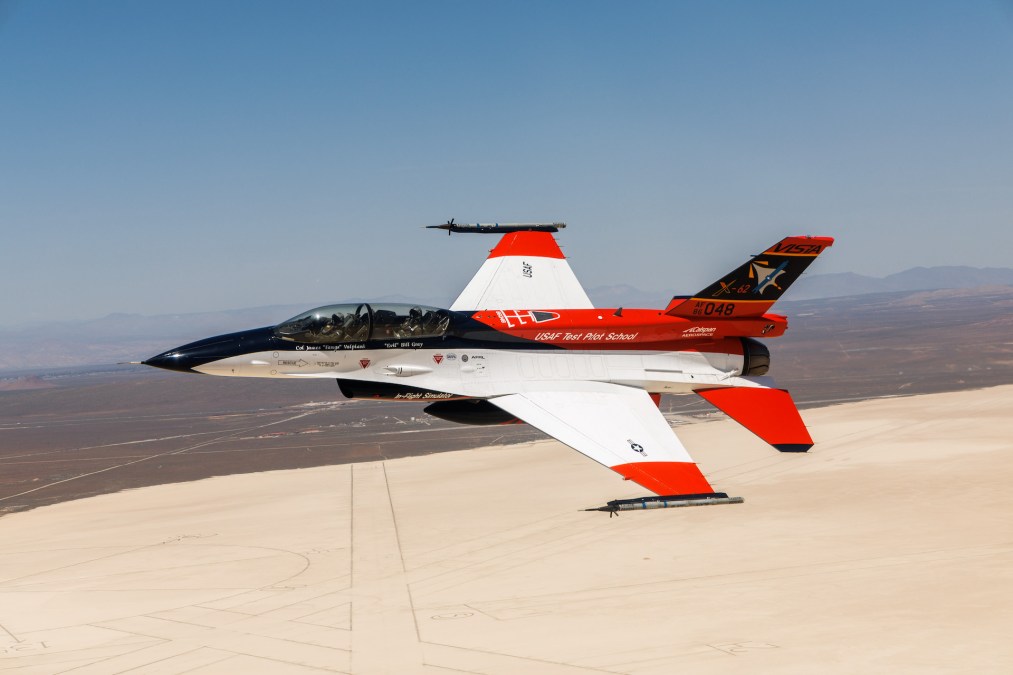Air Force’s Kendall: AI agents had ‘roughly an even fight’ against human F-16 pilot in recent engagements

The performance of a modified fighter jet equipped with algorithms that can maneuver the plane was nearly on par with the abilities of an experienced F-16 pilot during recent dogfighting exercises, according to Air Force Secretary Frank Kendall.
The Defense Advanced Research Projects Agency’s Air Combat Evolution program has been using the X-62A VISTA (Variable In-flight Simulator Test Aircraft) to put machine learning agents through their paces in the skies above Edwards Air Force Base, California. A total of 21 test flights were conducted for the project between December 2022 and September 2023.
Last week, Kendall traveled to Edwards and flew aboard the VISTA to witness within-visual-range engagements between the automated platform and an F-16 operated by an experienced Air Force pilot. Live rounds weren’t fired in the simulated combat, and there was a human pilot in the X-62 who could take control if things went wrong with the technology.
“What we did was we went up and did a number of test points to test out multiple versions of what we call agents that would take control of the airplane and conduct the maneuvering and put us in a position … to automate the engagement that might occur with either a short-range missile or the guns on the aircraft. So we did about 10 or a dozen different situations where … I was in the front seat and I had a button on my stick where basically I initiated the automation,” he said Wednesday at an AI expo event hosted by the Special Competitive Studies Project in Washington, D.C.
“Basically, when you’re in an engagement like that, what the two pilots are trying to do to gain an advantage is fly the most optimal possible trajectory for their aircraft … so you can get a missile off, and he’s trying to do the same to you. So the skill of the pilots is really important. We were up against a pilot who had two or three thousand hours of experience. He was very good. It was roughly an even fight. But against a less experienced pilot the AI … [and] the automation would have performed better,” Kendall said.
The Air Force secretary is bullish about AI agent-enabled fighter jets.
“That technology is not quite ready yet, but it’s making very good progress. We got to see three different versions of it. They all performed, I think, in a way which suggests to me personally very strongly that we’re on the right path and we’re gonna get to where we’re headed,” Kendall said.
The Air Force is pursuing next-generation drones known as collaborative combat aircraft (CCA) enabled by artificial intelligence. The service recently selected Anduril and General Atomics to create detailed designs, do manufacturing and conduct flight tests as part of the next phase of the program.
At the AI expo, Kendall noted that the dogfights with the VISTA were within-visual-range engagements. Although CCAs could do close-in battle, they are more oriented toward longer-range attacks that would use sensors and far-reaching weapons to target enemy aircraft.
“This is the path of the future,” he said. “That’s where we’re going.”
As the technology matures, robo-jets are expected to offer major advantages.
“They don’t get tired, they don’t get scared, they’re relentless. It’s easy to see a situation where they’re gonna be able to do this job … better than humans can do,” Kendall said.
The systems are expected to be superior to airmen when it comes to handling large amounts of data.
“When you get into a complex tactical situation, you get overloaded with the amount of input you’re getting and you’re trying to sort through and decide what to do. You simplify your decision-making process down to the things you need to handle and the basic skills that you have to simplify the problem for yourself. Our computers are not going to have to do that. They’re going to be able to handle that … level of complexity much better than a human can. There are just inherent limitations of human beings. And when we can build machines that can do these jobs better than people can do them, the machines are going to do the job,” Kendall said.
He noted that the Pentagon will need to make sure the AI-enabled systems are programmed with operational constraints.
“The United States is going to comply with the rules of armed conflict. We’re going to find ways to make sure that we do use our systems in ways that are acceptable, and we don’t have any more than necessary collateral damage. We won’t always be perfect about that, but we’re gonna work really hard at it,” he said.



